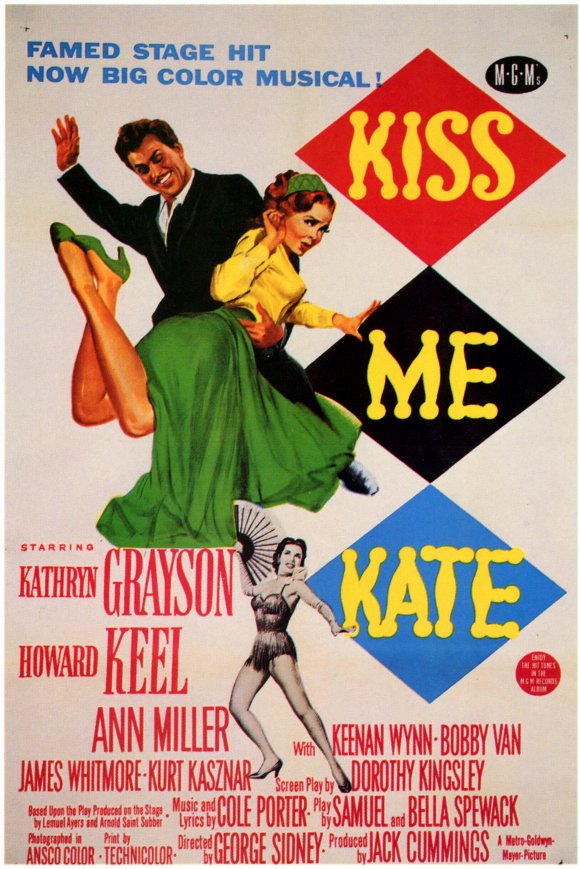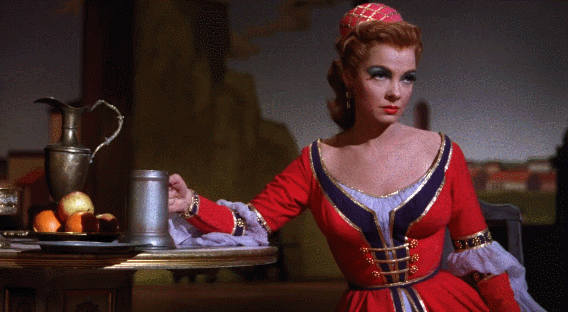 Our centennial tribute to MGM mainstay George Sidney continues with the director's 1953 musical Kiss Me Kate, and such a curious beast it is. Adapted with a slightly free hand from Cole Porter's hit 1948 musical, it's a musical version of The Taming of the Shrew that's also a backstage comedy about the staging of a musical version of The Taming of the Shrew, in which the actors playing Kate and Petruchio are recently feuding exes.
Our centennial tribute to MGM mainstay George Sidney continues with the director's 1953 musical Kiss Me Kate, and such a curious beast it is. Adapted with a slightly free hand from Cole Porter's hit 1948 musical, it's a musical version of The Taming of the Shrew that's also a backstage comedy about the staging of a musical version of The Taming of the Shrew, in which the actors playing Kate and Petruchio are recently feuding exes.
Don't let the plot worry you, though. Since this is a 1950s MGM musical the focus is obviously one one thing first and foremost, and that's big, heaving SPECTACLE.
The concept offers room for elaborate costumes in a rainbow of splashy colors, and of course the film takes full advantage; while choreographer Hermes Pan (and, for one jaw-dropping scene, the very young Bob Fosse) throws a lot of high-energy moves into the dances. But there's no question what sets Kiss Me Kate apart from the pack, even among MGM's big-budget productions: this was the studio's first musical in 3D, and it remains one of the best uses of that gimmick across the decades and three different waves of stereoscopic filmmaking. Warner Bros. released the film on a drop-dead gorgeous 3D Blu-ray in 2015, and if you keep your eyes peeled, it sometimes crops up in revival houses. It's worth whatever effort it takes: it's a revelation in 3D, and that has everything to do with Sidney's excellent staging of the action.

Sure, there's the usual gamut of cheap 3D tricks: Ann Miller tossing scarves at the camera, Kathryn Grayson flinging mugs of water, jugglers launching bowling pins straight at our faces. Which is, I would insist, a perfectly okay thing to do. Let's say, though, that you need a bit more than that: Sidney provides it. Like all the best 3D movies, Kiss Me Kate makes plenty of gestures towards creating a deep space for the action, using the open space of the theatrical stage and backstage to create multiple planes of activity, and all sorts of useful visual analogues for the emotional conflict.
 One of the pervasive gestures throughout the movie is direct address: characters completely abandon the reality of the scene to deliver their songs, and sometimes even dialogue, straight to the camera. It's weird in the 2D version of the movie, but it suddenly feels perfectly natural when the extra depth is added, giving the sense that we the viewers are involved in the action somehow. When Howard Keel performs "Where Is the Life That Late I Led" on a thrust stage, surrounded by the theatrical audience, the film's intent is clear: it's trying to recreate, in cinema, the unique sense of shared space that happens in theatrical performance. It doesn't work and probably can't, but it's a pretty fun failed attempt.
One of the pervasive gestures throughout the movie is direct address: characters completely abandon the reality of the scene to deliver their songs, and sometimes even dialogue, straight to the camera. It's weird in the 2D version of the movie, but it suddenly feels perfectly natural when the extra depth is added, giving the sense that we the viewers are involved in the action somehow. When Howard Keel performs "Where Is the Life That Late I Led" on a thrust stage, surrounded by the theatrical audience, the film's intent is clear: it's trying to recreate, in cinema, the unique sense of shared space that happens in theatrical performance. It doesn't work and probably can't, but it's a pretty fun failed attempt.
None of which should imply that Kiss Me Kate isn't worth your time in the good ol' 2D version that has been, for decades, the only way to see it. In all versions, the film is a lot of fun, with Porter's enjoyable, if hardly top-tier collection of upbeat songs (scrubbed clean for the movies at the censors' behest, though "Kick her right in the Coriolanus" stayed in) handled with big showy gusto. The whole thing is resolutely trivial: it's a soap bubble of a romantic comedy that pulls in a couple of powerfully unthreatening gangsters to add some measure of a plot. Accordingly, Sidney and the cast treat it as a big lark, and there's a definite "let's put on a show" vibe to the performances, especially Miller's completely unrestrained joy at shimmying every chance she gets, and Grayson's embrace of the hammy potential in playing a character called "the shrew" in what was her very best screen performance (Sidney had a special hand for working with Grayson: just look at the number Dan discussed last time).

It's a big piece of eye and ear candy, and nothing else really; but where better to get that than MGM at its '50s biggest? And in Sidney's estimable career as a director of musicals, he never topped how much goofy, good-natured fun this film is for every minute of its running time.